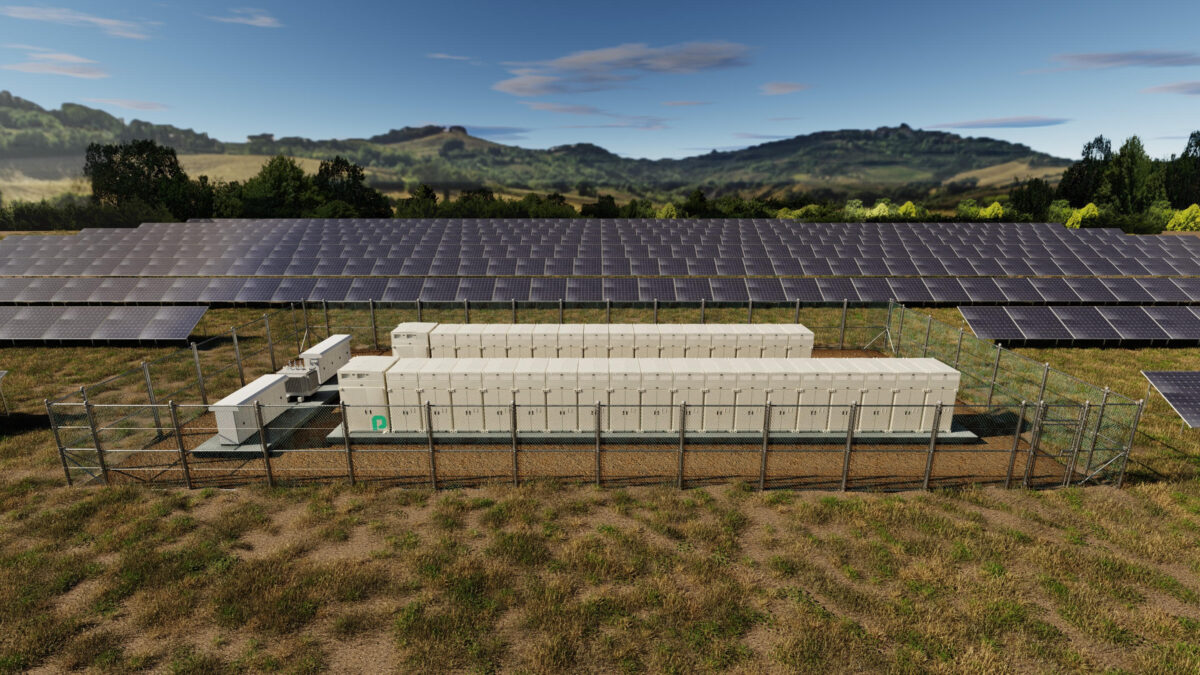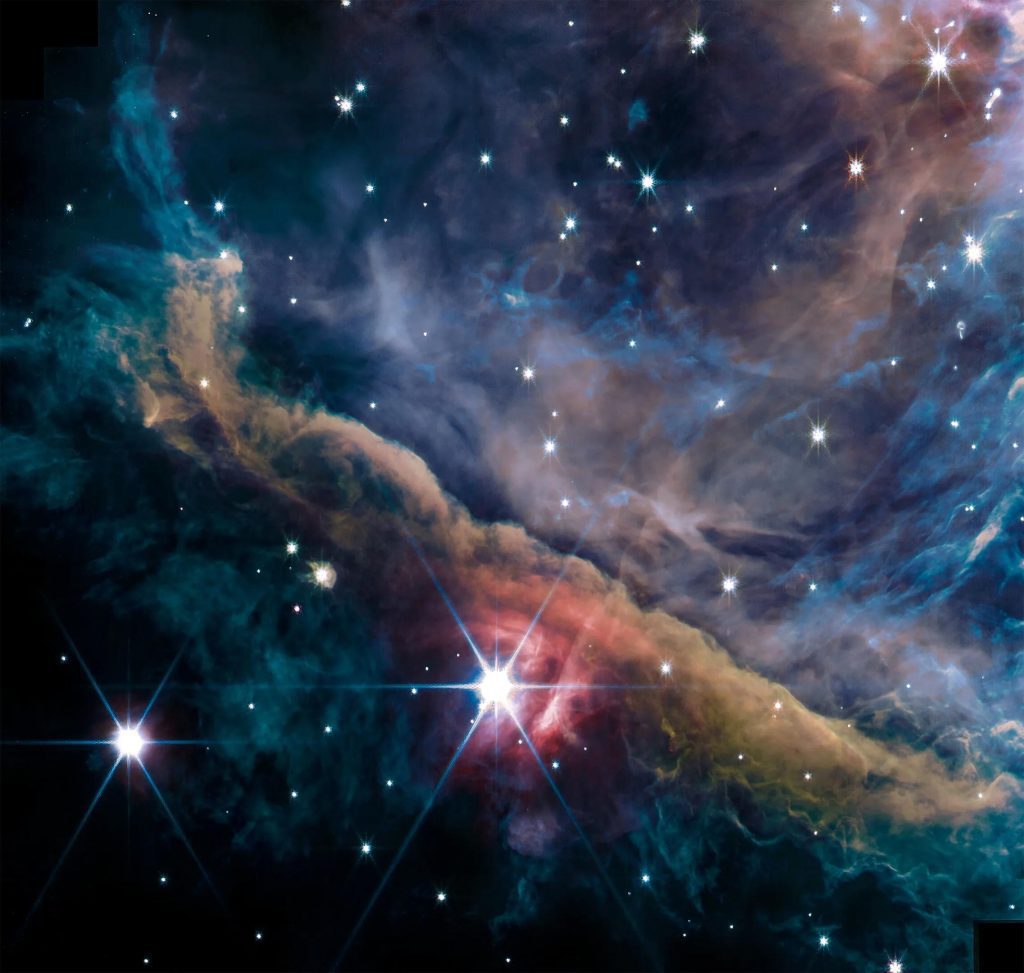Het interieur van de Orionnevel zoals gezien door het NIRCam-instrument van de James Webb Space Telescope. Dit is een samengestelde afbeelding van verschillende filters die de emissies van geïoniseerd gas, moleculair gas, koolwaterstoffen, stof en verstrooid sterlicht voorstellen. Het meest opvallend is de Orion Bar, een muur van dik gas en stof die van linksboven naar rechtsonder in deze afbeelding loopt en die de heldere ster bevat θ2 Orionis A. Het tafereel wordt verlicht door een groep hete, jonge massieve sterren (bekend als de Trapeziumcluster) net buiten de rechterbovenhoek van de afbeelding. De sterke, harde UV-stralen van de Trapezium-array creëren een hete ioniserende omgeving in de rechterbovenhoek, waardoor de Orion-balk langzaam wegvaagt. Deeltjes en stof kunnen langer overleven in de beschutte omgeving die wordt geboden door het dichte lint, maar de uitbarsting van stellaire energie snijdt een gebied uit dat een verbazingwekkende rijkdom aan filamenten, bolletjes en jonge sterren met schijven en holtes vertoont. Krediet: NASA, ESA, CSA, gegevensreductie en -analyse: PDRs4All ERS-team; S. Fuenmayor Grafische verwerking
Nieuwe webafbeeldingen onthullen een geweldig uitzicht op de Orionnevel
“We are blown away by the breathtaking images of the Orion Nebula. We started this project in 2017, so we have been waiting more than five years to get these data,” said Western University astrophysicist Els Peeters.
These images have been obtained as part of the Early Release Science program Photodissociation Regions for All (PDRs4All ID 1288) on JWST. Co-led by Peeters, French National Centre for Scientific Research (CNRS) scientist Olivier Berné, and Institut d’Astrophysique Spatiale (IAS) associate professor Emilie Habart, PDRs4All is an international collaboration that involves a team of more than one hundred scientists in 18 countries. Other Western University astrophysicists involved in PDRs4All include Jan Cami, Ameek Sidhu, Ryan Chown, Bethany Schefter, Sofia Pasquini, and Baria Kahn.

Young star with disk inside its cocoon: Planet forming disks of gas and dust around a young star. These disks are being dissipated or “photo-evaporated” due to the strong radiation field of the nearby stars of the Trapezium creating a cocoon of dust and gas around them. Almost 180 of these externally illuminated photoevaporating disks around young stars (aka Proplyds) have been discovered in the Orion nebula, and HST-10 (the one in the picture) is one of the largest known. The orbit of Neptune is shown for comparison.
Filaments: The entire image is rich in filaments of different sizes and shapes. The inset here shows thin, meandering filaments that are especially rich in hydrocarbon molecules and molecular hydrogen.
θ2 Orionis A: The brightest star in this image is θ2 Orionis A, a star that is just bright enough to be seen with the naked eye from a dark location on Earth. Stellar light that is reflecting off dust grains causes the red glow in its immediate surroundings.
Young star inside globule: When dense clouds of gas and dust become gravitationally unstable, they collapse into stellar embryos that gradually grow more massive until they can start nuclear fusion in their core – they start to shine. This young star is still embedded in its natal cloud.
Credit: NASA, ESA, CSA, Data reduction and analysis: PDRs4All ERS Team; graphical processing S. Fuenmayor & O. Berné
“These new observations allow us to better understand how massive stars transform the gas and dust cloud in which they are born,” said Peeters. She is a Western University astronomy professor and faculty member at the Institute for Earth and Space Exploration.
“Massive young stars emit large quantities of ultraviolet radiation directly into the native cloud that still surrounds them, and this changes the physical shape of the cloud as well as its chemical makeup. How precisely this works, and how it affects further star and planet formation is not yet well known.”
The newly released images reveal numerous spectacular structures inside the nebula, down to scales comparable to the size of the Solar System.
“We clearly see several dense filaments. These filamentary structures may promote a new generation of stars in the deeper regions of the cloud of dust and gas. Stellar systems already in formation show up as well,” said Berné. “Inside its cocoon, young stars with a disk of dust and gas in which planets form are observed in the nebula. Small cavities dug by new stars being blown by the intense radiation and stellar winds of newborn stars are also clearly visible.”
Proplyds, or ionized protoplanetary disks, consist of a central protostar surrounded by a disk of dust and gas in which planets form. Scattered throughout the images are several protostellar jets, outflows, and nascent stars embedded in dust.
“We have never been able to see the intricate fine details of how interstellar matter is structured in these environments, and to figure out how planetary systems can form in the presence of this harsh radiation. These images reveal the heritage of the interstellar medium in planetary systems,” said Habart.

Orion Nebula: JWST versus Hubble Space Telescope (HST): The inner region of the Orion Nebula as seen by both the Hubble Space Telescope (left) and the James Webb Space Telescope (right). The HST image is dominated by emission from hot ionized gas, highlighting the side of the Orion Bar which is facing the Trapezium Cluster (off the top right of the image). The JWST image also shows the cooler molecular material that is slightly further away from the Trapezium Cluster (compare the location of the Orion Bar relative to the bright star θ2 Orionis A for example). Webb’s sensitive infrared vision can furthermore peer through thick dust layers and see fainter stars. This will allow scientists to study what is happening deep inside the nebula.
Credit: NASA, ESA, CSA, PDRs4All ERS Team; image processing Olivier Berné.
Credit for the HST image: NASA/STScI/Rice Univ./C.O’Dell et al. – Program ID: PRC95-45a. Technical details: The HST image used WFPC2 mosaic. This composite image uses [OIII] (blauw), geïoniseerde waterstof (groen), en [NII] (rood).
Analoge evolutie
De Orionnevel wordt lange tijd beschouwd als een omgeving die lijkt op de bakermat van het zonnestelsel (toen deze meer dan 4,5 miljard jaar geleden werd gevormd). Dit is de reden waarom wetenschappers tegenwoordig geïnteresseerd zijn in het observeren van de Orionnevel. Ze hopen naar analogie te begrijpen wat er gebeurde tijdens de eerste miljoen jaar van de evolutie van onze planeet.
Omdat de kernen van stellaire kraamkamers zoals de Orionnevel worden verduisterd door grote hoeveelheden sterrenstof, is het onmogelijk om te bestuderen wat er binnenin in zichtbaar licht gebeurt met telescopen zoals Hubble Ruimtetelescoop. Webb detecteert een bestand infrarood licht van de kosmos, waardoor astronomen deze stoflagen kunnen zien en beweging kunnen detecteren die zich in de diepten van de nevel voordoet.

Het interieur van de Orionnevel zoals gezien door de Spitzer Ruimtetelescoop (links) en de James Webb Ruimtetelescoop (rechts). Beide beelden zijn opgenomen met een filter dat bijzonder gevoelig is voor emissies van koolwaterstofstof dat over het hele beeld gloeit. Deze vergelijking laat op verbluffende wijze zien hoe ongelooflijk nauwkeurig de beelden van Webb zijn vergeleken met hun infraroodvoorloper, de Spitzer Space Telescope. Dit is direct te zien aan de complexe filamenten, maar Webbs scherpe ogen stellen ons ook in staat om sterren beter te onderscheiden van protoplanetaire bolletjes en schijven.
NIRCam-afbeeldingscredits: NASA, ESA, CSA, PDRs4All ERS-team; Beeldverwerking door Olivier Bernet.
Spitzer afbeelding tegoed: NASA/JPL-Caltech/T. Meggeth (Universiteit van Toledo, Ohio)
Technische details: De Spitzer-afbeelding toont infrarood licht van 3,6 micron dat is vastgelegd door de Spitzer Infrared Array Camera (IRAC). De JWST-afbeelding toont infrarood licht van 3,35 m dat werd vastgelegd door de JWST NIRCam. Zwarte pixels zijn artefacten die worden veroorzaakt doordat de detectoren verzadigd zijn met heldere sterren.
“Het observeren van de Orionnevel was een uitdaging omdat het te helder is voor de ongekend gevoelige apparaten van Webb. Maar Webb is ongelooflijk, Webb kan ook verre en zwakke sterrenstelsels waarnemen.”[{” attribute=””>Jupiter and Orion, which are some of the brightest sources in the infrared sky,” said Berné.
At the heart of the Orion Nebula is the ‘trapezium cluster’ (also known as Theta Orionis), which was discovered by Galileo. It contains young massive stars whose intense ultraviolet radiation shapes the cloud of dust and gas. Understanding how this intense radiation impacts their surroundings is a key question in understanding the formation of stellar systems like our own solar system.
“Seeing these first images of the Orion Nebula is just the beginning. The PDRs4All team is working hard to analyze the Orion data and we expect new discoveries about these early phases of the formation of stellar systems,” said Habart. “We are excited to be part of Webb’s journey of discoveries.”
Webb is the most powerful space telescope ever created in human history. It was developed in partnership with NASA, the European Space Agency, and the Canadian Space Agency (CSA), and boasts an iconic 6.5-meter-wide mirror, consisting of a honeycomb-like pattern of 18 hexagonal, gold-coated mirror segments and a five-layer, diamond-shaped sunshield the size of a tennis court. As a partner, CSA receives a guaranteed share of Webb’s observation time, making Canadian scientists some of the first to study data collected by the most advanced space telescope ever constructed.

“Amateur-organisator. Wannabe-bierevangelist. Algemene webfan. Gecertificeerde internetninja. Fanatieke lezer.”










More Stories
UF-wetenschappers hopen de dodelijke bronzingziekte in palmbomen in Florida te stoppen
Oude opgravingen hebben geleid tot de ontdekking van de grootste bekende zeereptielen
Starlink-missie woensdagavond vanaf KSC